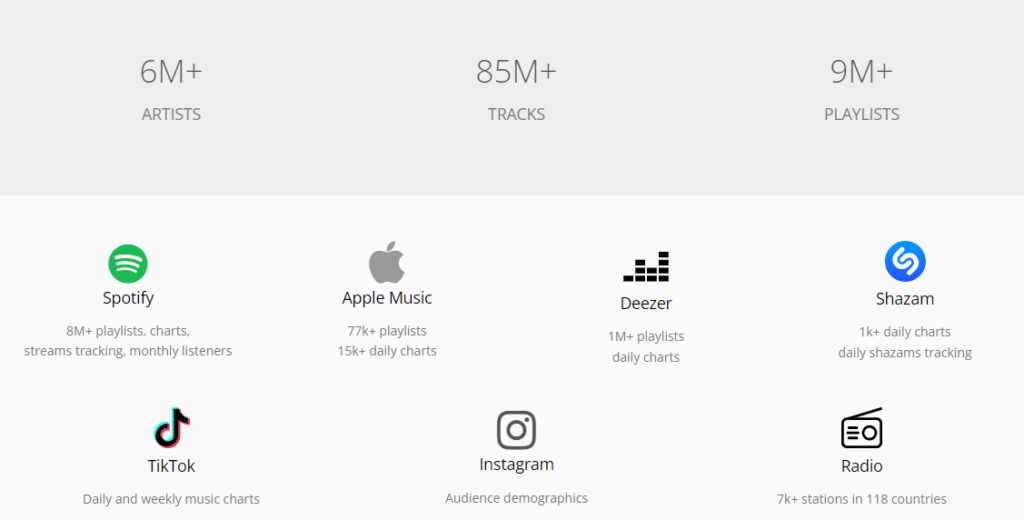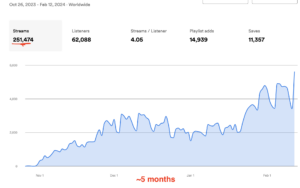Imagine waking up in the middle of the night only to discover that all your tracks have been taken down from Spotify due to being added to a botted playlist. I wouldn’t wish that on my worst enemy.
Let’s be honest: getting your music on a fake playlist is a nightmare for any musician who is trying to grow their fanbase on a streaming platform like Spotify or Apple Music.
In the best-case scenario, your stats will get all messed up, and the platform’s algorithm won’t be able to push your music to the right places and recommend it to potential listeners. The absolute worst that can happen is that your song or an album will be removed from the platform. A total disaster.
Fortunately, there are tools and strategies that can help you identify if the playlist is worth your effort before submitting your music to the playlist curator.
In this article, I will focus on Spot On Track an analytics platform that is not only useful in detecting fake Spotify playlists but also provides tons of handy data and stats to help you navigate your music career in a safe and informed manner.
Let’s see what Spot On Track has to offer.
Spot On Track: Overview
Spot On Track is a tool that enables you to track your Spotify, Apple Music, and Deezer playlists and charts from a song/artist perspective. Additionally, it also offers radio play stats, retrieving all data directly from APIs.
Spot On Track was launched in 2016 by Studiweby, a software company based in Belgium.
Julien Mahin, the brain of the company, uses his passion for music and expertise in computer science to provide science-based solutions to address the complex needs of the digital music world.
Studioweby stands behind a few other products you might be familiar with, including BP Top Tracker, PlaylistSearch.io, and a Spotify playlist analyzer called Is It a Good Playlist?
Spot On Track is the most successful kid in the Belgian company family.
Spot On Track: Service
At the time of writing, Spot On Track was tracking over 9 million Spotify playlists, almost 83 thousand Apple Music, and 100 thousand Deezer playlists, with new playlists being added every day. The biggest difference between Spot On Track and, for example, Spotify for Artists is that the platform analyzes millions of tracks and playlists across various platforms rather than share data limited to the artists’ songs.

Spot On Track started off as a relatively basic tool to track playlist performance across streaming services. The platform has since introduced a number of features that made it a professional-level analytic tool, competing with the top players in the industry, like Chartmetric or Soundcharts. If you want to see how Spot On Track performs vs. Chartmetric, check out my comparing review of both platforms.
Let’s see what metrics are included in the Spot On Track subscription plan:
Track analytics
Track analytics include all the info you might need on song performance, from chart positions to playlist auditions and new releases on the platforms.
Spot On Track publishes its own charts that will show you all the tracks and their performance on a given day on a selected platform. The data sources include Spotify, Apple Music, Deezer, Shazam, Radio, and TikTok.
You can see whether a song moved the position in the chart and how many plays it has, choose the data range, and view the global or selected country’s stats. For example, the Spotify chart lets you choose between data from Streams, Viral, and New Music Friday.
After clicking on each song, you can view more detailed analytics, including an overview of the performance across the charts and playlists; Spotify streams complete historical data, releases history, charts’ current position, peak moments and evolution, complete current and removed playlists data and detailed stats from Shazam, Tiktok, and radio (as an add-on).
You can search for any track (or playlist, artist, or album) using the search engine on the platform by entering a URI/I/link/name.
Note that the data displayed for each platform differs slightly due to differences in data accessible through APIs.
Everything you see on the screen is easily downloadable in the CVS format.
Playlist and chart analytics
Playlist and chart stats include data on millions of playlists across Spotify, Apple Music, and Deezer. The stats are updated daily.
You look for playlist data by entering a link into the search engine on the website; it will let you view all tracks and the follower base’s complete historical data. Again, you can download all the data in CSV.
How do you use Spot On Track to detect false playlists?
If you have your music on Spotify or Apple Music sooner or later, you will need a tool that will help you assess playlist quality. Spot On Track is one of them. Some platforms, like artist.tools, will also let you contact curators directly through the platform.
Back to Spot On Track – how does it work?
Copy and paste the link to the playlist you are interested in. Head over to the Spot On Track search engine and enter the link into the playlist search bar. The playlist should pop up in the results below. Select your playlist and head to the followers section in the data display results.
Here, you can see the followers’ growth over the selected period of time, basically from forever to the last month’s data. Now, if you see nice and steady growth like in the chart below, it means that the playlist is most likely legitimate.
If there are any sudden and unrealistic spikes in the number of followers, that’s a sign that you should probably stay away from this playlist. That’s it! Sweet and simple.
Radio station analytics
Radio data includes stats from over 6,000 radio stations across 116 countries. As I already mentioned, radio data is available only as an add-on, and for $24.99, you get access to a track’s data for a year.
Once you purchase a track subscription, you can view the number of plays, impressions, countries, and stations where the song was played over the selected period of time.
The radio charts feature plays and impressions in the top 20 countries and radio stations. On top of that, you will see a nicely-looking graph presenting the track’s evolution and a global map displaying plays and impressions performance.
Social media performance analytics
Social media data includes Spot On Track’s own TikTok and Shazam music charts, as well as data analytics for TikTok songs. This way, you can track viral songs and get detailed insights on any song.
You also get demographic data on Instagram audiences.
Reporting Tools
You can customize your dashboard using various filters so that it displays the information that you are interested in the most.
Spot On Track makes all this data easily accessible by sending you Daily Digest – a daily email summary with all stats and data related to the items you follow combined in one place. Once you opt-in to receive the emails, you can select the artists, playlists, and tracks that you want to include in your daily report. It’s a handy option to view all your new playlist additions and chart stats without logging into the platform.
On top of email reporting, you can create personalized PDF reports with your company logo on them. You can produce a one-off report or have it regularly delivered to your email address once a day, every week, or a month.
Once you create a PDF report on each playlist or track available on the platform, it will give you the option to select data points that you want to include, a format (charts or graphs) to present your data summary, locations, etc. Tons of stuff.
Customer Support
Customer support is not the strongest point here; you can email the support if you have any queries, but there is no chat support available. The help center includes an FAQ section and tutorials on how to start using the platform, for example, how to set up your dashboard, how to create a Super Friday report, etc.
Spot On Track: Price
Spot On Track offers only one “Analytics” plan at $29.99 per month or $299 if you pay upfront for a year. You get access to everything that’s currently offered on the platform for this price.
The plan comes with a 14-day trial, and you don’t need to enter your credit card details to try it out.
To get data on radio plays, you need to pay an extra $24.99 per song to be able to track it for a year. It’s worth noting that a radio data add-on can be purchased only with an active subscription plan.
The “Discovery” plan, featuring on top of all options available on the Analytics plan and also the A&R Discovery tool, has been listed as “coming soon” for the last few months, and there is no exact information on when it will be launched. Once it does, I would be curious to see how it performs against big players like Chartmetric.
Spot On Track: Pros and Cons
Pros:
- You get access to comprehensive data analytics on the basic “Analytics” plan (and it is the only plan they offer).
- A 14-day trial is available (no credit card required).
- You can use it to track and evaluate playlists.
- It’s super easy and accessible to export filtered data in PDF or CSV.
- Daily Digest email summary available on request.
Cons:
- There is no affordable “artist” plan.
- They don’t have a free plan.
- Radio data is only accessible as a (costly) add-on.
Are music analytics tools worth it?
The short answer is yes. The longer answer is it depends on various aspects. If your goal is to promote your music on Spotify or any other streaming platform, having access to playlist data is a no-brainer.
There are tools that will cost half of what Spot On Track and will offer you enough information to run your career. Others will cost much more and provide so much data that you will struggle to find time to analyze all of the information.
Before you start using any of them, you should look at these factors:
- Do I have time (and budget) to invest on it? The best analytic tool won’t help you if you don’t use the data it provides to develop your promotional strategy.
- Is my music good enough to be playlisted? Ok, it’s not easy to judge, especially if you are talking about your own music, but it only makes sense to invest in songs that have the potential to get heard. That’s why it’s also super important to identify the right playlists for your music.
- Quality of the service. You may not need all fancy-pants features if you are just starting out. You can begin by using built-in analytics like Spotify for Artists or Apple Music for Artists and add on more tools as your career progresses. Spot On Track might be one of the best platforms out there, but only as long as it suits your needs.
Final Notes
Spot On Track offers an all-embracing data analytics service for a relatively low price; it’s a good choice if you are looking for a middle-ground solution somewhere between highly advanced stats and affordability.
While it doesn’t have a low-cost plan directed towards early-career artists, like Chartmetric, it gives you access to data and analytics that can easily support a professional career. It’s worth noting that other platforms, including Chartmetric or Soundcharts, will charge up to five times more for a similar service.
If radio plays are what you’re after, then Spot On Track isn’t probably the best choice for you, as it charges extra for each song that you want to track.
All in all, Spot On Track is a comprehensive music data analytics tool that will provide you with everything you need to understand charts and playlists on Apple Music and Spotify without breaking the bank.
Anyhow, before you subscribe to the service, make good use of the 14-day trial to decide whether it’s really worth your money.
Good luck!









